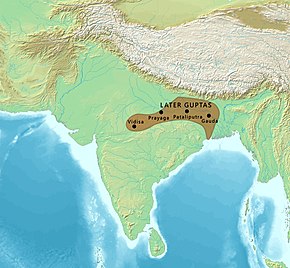|
Later Gupta dynasty
The Later Gupta dynasty, also known as the Later Guptas of Magadha, were the rulers of Magadha and Malwa from the 6th to 8th centuries CE. The Later Guptas emerged after the disintegration of the Imperial Guptas as the rulers of Magadha and Malwa however, there is no evidence to connect the two dynasties and the Later Guptas may have adopted the -gupta suffix to link themselves with the Imperial Guptas.[3] There are several important sources of information regarding the Later Guptas including two epigraphs, the Aphsad inscription of Ādityasena, which sets out the genealogy of the ruling family from Kṛṣṇagupta to Ādityasena, and the Deo Baranark inscription of Jīvitagupta II. The Harshacharita of Bāṇabhaṭṭa is also an important source of information as are the records of the Chinese pilgrims Xuanzang and Yijing which also mentions them. The Gaudavaho of Vākpatirāja refers to the victory of King Yashovarman of the Varman dynasty against the king of Magadha, with the scholarly consensus being that this is a reference to Jīvitagupta II.[4][5] OriginsThe general consensus among researchers of the period is that the Later Guptas emerged from the Magadha region of what is now Bihar in India. The reasoning behind this is that all inscriptions relating to the dynasty have been found in this region. A Nepalese inscription also refers to King Ādityasena as the "Lord of Magadha". They were likely originally feudatories under the Imperial Guptas and came into possession of large territories in Magadha following the fall of the Empire.[6] HistoryAfter the decline of the Gupta Empire, the Later Guptas succeeded them as the rulers of Magadha.[3] The daughter of the dynasty's founder Krishnagupta is said to have married prince Adityavarman of the Maukhari dynasty. According to the Aphsad inscription of Ādityasena, Krishnagupta's grandson Jivitagupta carried out military expeditions in the Himalayan region and southwestern Bengal.[7] During the reign of Jivitagupta's son Kumaragupta, the dynasty developed a rivalry with the Maukharis for control of the Ganges valley.[4] Kumaragupta defeated the Maukhari king Ishanavarman in 554 CE, and extended his territory to Prayaga. His son Damodaragupta suffered reverses against the Maukharis and was pushed back into Magadha.[7] Damodaragupta's son Mahasenagupta allied with the Pushyabhuti dynasty. His sister married the ruler Adityavardhana. He invaded Kamarupa and defeated Susthita Varman.[7] But he subsequently faced three invaders: the Maukhari king Sharvavarman, the Kamarupa king Supratishthita-varman, and the Tibetan king Songtsen. His vassal Shashanka also abandoned him (and later established the independent Gauda Kingdom). The Maukhari king Sharvavarman is thought to have defeated Damodaragupta, invading Magadha circa 575 CE, which made him ruler of the entire Uttar Pradesh.[8][9] Under these circumstances, Mahasenagupta was forced to flee Magadha, and take shelter in Malwa. Subsequently, the Pushyabhuti emperor Harsha (ruled c. 606 – c. 647 CE) restored the Later Gupta rule in Magadha, and they ruled as Harsha's vassals.[3] After Harsha's death, the Later Gupta ruler Adityasena became the sovereign ruler of a large kingdom extending from the Ganges in the north to the Chhota Nagpur in the south; and from Gomati River in the west to the Bay of Bengal in the east.[10] However, he was defeated by the Chalukyas.[11] Jivitagupta II, the last known ruler of the dynasty, appears to have been defeated by Yashovarman of the Varman dynasty of Kannauj circa 750 CE.[10] Coinage Coinage from the reign of the Later Gupta kings has been relatively scarce. So far the only coins discovered are from the period of Mahasenagupta who ruled from 562-601 CE. The numismatic evidence makes it clear that the Later Guptas were devout Shaivites with depictions of Nandi replacing the depictions of Garuda that were present in the coinage of the imperial Guptas. Two types of coinage from Mahasenagupta's reign have been discovered, the "archer type" and the "swordsman type".[1] List of rulersThe known Later Gupta rulers include:[12][13][14] 
Possible descendantsGuptas of JayapuraA small kingdom that ruled the area around Lakhisarai district during the 11th and 12th centuries bore the name Gupta and have subsequently been linked as a surviving line of the Later Guptas.[15] Evidence of their rule comes from the Panchob copper-plate inscription which was discovered in 1919.[16] References
Bibliography
|
||||||||||||||||||||||||||||||||||||||
!["Swordsman type" gold coin of Mahasenagupta from the 6th century CE. On the obverse, the King is shown holding a sword in his left hand. On the reverse, a Goddess is shown seated in a lotus pose.[1] of Later Gupta dynasty](http://upload.wikimedia.org/wikipedia/commons/thumb/c/c5/Swordsman_type_coinage_of_Mahasenagupta_of_the_Later_Gupta_dynasty.png/300px-Swordsman_type_coinage_of_Mahasenagupta_of_the_Later_Gupta_dynasty.png)


